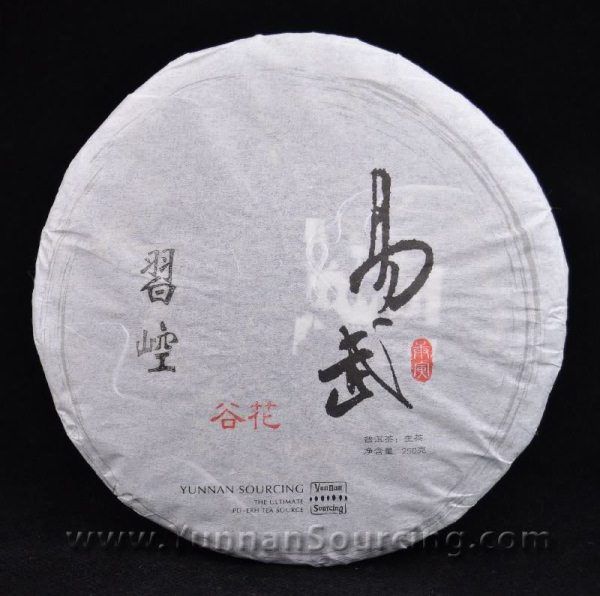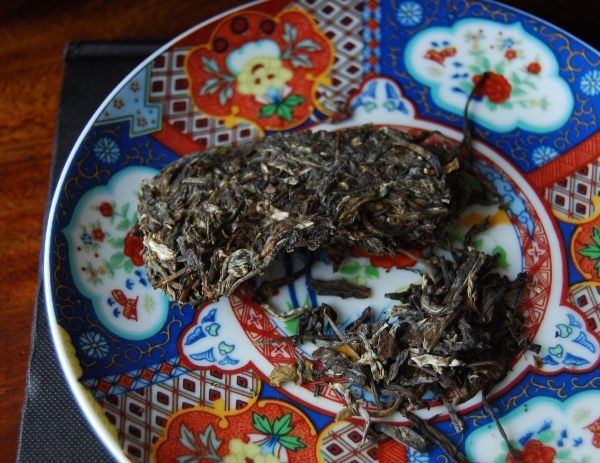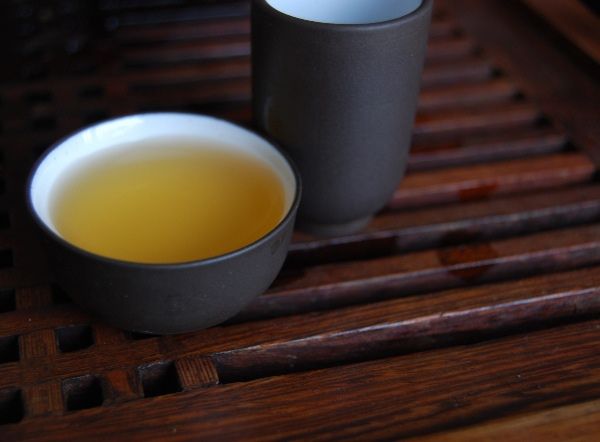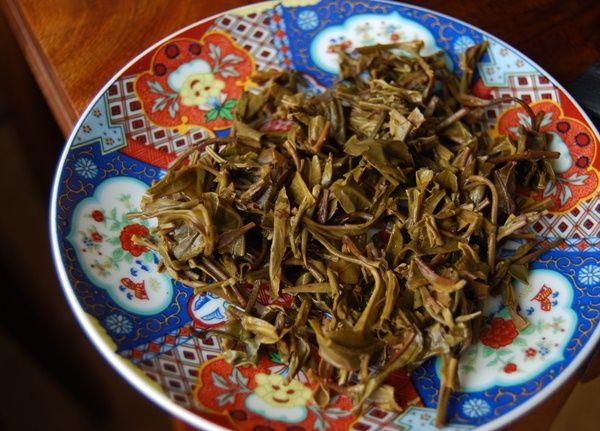When I first started drinking pu'ercha, I received some wisdom from a tea-shop seller in Chengdu: "drink shupu in winter, drink shengpu in summer". As regular readers may have come to appreciate, I promptly disregarded this advice.
Lately, however, it has been baking hot in England, despite it being only April. For the first time in as long as I can remember, we had an Easter barbecue and I developed a fetching sunburn. Certainly, our climate is not on the same scale of that in central China or Arizona, but, for we feeble race of fog-dwellers, it is the hottest temperature imaginable. It feels as if my eyeballs are going to melt.
This parched heat turns the act of drinking shengpu in the morning into a definite treat, even moreso than usual. By sheer chance, after spending a good few hours with this tea, a quick read of Scott's web-pages at Yunnan Sourcing reveal that he recommends this cake for drinking on a hot day. What peculiarly good luck...
Have you ever come across something by the name of "Xikong" [shee kong] before? It is entirely new to me, and again reminds me just how delightful it is, and how fortunate we are, to be able to sample leaves from around the less-travelled parts of Yunnan province.
Xikong is kinda-sorta in the Yiwu region, being in Mengla County of Xishuangbanna, which is the bit that sticks out into Laos. As such, I expect a little "outlying" character to be found, and this excites me: I completely adore the unique granary, sweet characteristics that I associate with that area. If more cakes came from this region, I would be a happy drinker - and I am, by dint of nature, a habitually happy drinker.
The varietal that grows around this area is a xiaoye [sheow yeah, small leaf] type, which I find to be a touch more fruity and sweet than the usual daye [dar yeah, big leaf] type.
So, then, to the tea itself. Scott's samples always take me by surprise when I unseal them from their tightly-packed little foil pouches: the aroma leaps out and wrestles the nose into submission. This Xikong is grassy and fresh in its scent, and could have easily convinced me that it is a springtime tea, rather than the autumnal growth that it is. You can see from the image above that the leaves are, indeed, of a small variety.
Happily, this is a straight yellow tea (pictured above). I have consumed, it seems, so much one-year tea that turns out fat, husky orange, that to have something unadulterated and properly raw is quite a relief.
Further encouraging me, the scent marches proudly in the aroma cup, long and strong, with no sign of diminishing as the infusions continue.
Happy days: this is a fine example of the region's tea. Sweet, grapefruit-like, with a goodly amount of smooth buttery, sweetness in the finish paint a complex picture for the drinker to appreciate. It squats determined in the throat, with an excellent kuwei [bitter flavour], and a satisfyingly fat, chunky body.
I could drink this until the proverbial cows come home, and thoroughly enjoy a prolonged session with it.
It has the clean, sweet-cereal "outland" nature that I so long to find, and avoids being rough, courtesy of Scott's decent selection of leaves. On passing the table, my dear wife takes a sip, remarking "Too bitter for me!" but, between you and me, it's just about right. (Assuming that you like nasty, bitter tea, as do I.)
Scott sells two strata of autumnal cakes: a cheaper layer, costing around $20 / 250g xiaobing, and a more expensive layer, costing around $40 / 250g xiaobing. This cake is in the latter, and deservedly so. Of course, its equivalent 375g bing price is around $60, which makes one pause for thought - that isn't the sort of money that I would spend on a one-year cake without significant consideration. However, it is a lovely tea, and it appeals to my idiosyncrasies. I hope to buy one or two cakes for fun.
Addendum
November, 2011
I was unsuccessful in buying this from Yunnan Sourcing, where it quickly sold out. I should learn to buy before I write! I since bought it from a stock that Scott had reserved for his US venture. The price was higher, in the $50s somewhere.
This time, with my own cakes in hand, I find it sweet and buttery, with a dry, granary body. It has good potency and endures well. It keeps my interest, and I find it absorbing - surely a compliment. I enjoy its sweet, rough nature.
I sweet leaves and then burn garden waste in a fire. Cold, happy days...






16 comments:
Dang, when I drunk it, I got pretty much no bitterness. Wasn't a problem since I got the huigans and all and the flavor was good, so I didn't lengthen brewing times...
So you'd still rather have the WanGonZhai?
--shah8
Hmmm, I used very whole leaves, didn't break most of them. The used leaves here looks pretty choppy.
-shah8
I didn't know where to post this, but do you have any tips on where to buy decent darjeeling and assam tea?
Love the blog!
Olav
Hi Hobbes,
the tea looks nice indeed!
Btw. have you had the Yi Wu Purple tea from Scott? The one for $15... I found it to be quite a surprisingly good tea! And it, in my opinion, shows that an anti-plantation attitude is not always based on reality. It is known that Yi Wu plantations are generally very good, of course, but that tea is pretty special anyway.
I have to agree with Jakub.. I bought the purple tea (autumn) buying spring next order. It was pretty good! I tasted chocolate and an ever faint hint of orange. Something else that didn't sit well but it was very smooth tea. I will likely buy another for the price.
Exactly, I tasted chocolate in it too.
Plus, when brewed with good water (around 85°, which is probably cold for most sheng), it was very fruity: blackberries and blueberries, quite overwhelming (and pleasant).
Given the price, I have bought it immediately.
Thanks for the tip! I will try a lower temp. I always use spring water but I am trying to find the perfect source.
Some sources of spring water have too many dissolved minerals etc which will flatten the flavor or change the taste significantly. I will gladly take any advice in this area.
James: Well, you're lucky to have a source of spring water nearby, nothing like that here in Prague.
It is difficult with minerals - I do not fully understand it, but some minerals are obviously too "hard" and flatten and "ironize" the taste. On the other hand, when water is filtered too much, it becomes flat and boring too.
I mostly use tap water filtered with Brita filter - I think it is quite all right. The best water I can make is tap water filtered with Brita and then boiled in a porous clay kettle boiled on charcoal... the water has great qi, is soft, yet very full.
Thats actually some pretty good advice (with the boiling water in a porous clay kettle) I will try it.
Here the tap water is pretty horrid, way to much chlorine and I can taste lake.
I usually buy bottled water as I can't get the chlorine taste out even with a filter.
Tried a lower temp on the YS Autumn purple leaf per Jakub's advice.
80-85C seems to have done the trick. Guess I was burning the leaves. The unsavory taste I was getting before with 90-100C is much lighter. This is now a much finer tea to drink. Thank you!
Apologies for the delay in replying - we've had a long holiday week-end here in England.
Shah - the Wangongzhai and this cake are very different; I think I prefer them equally. The former is an orthodox Yiwu; the latter is a chunky xiaoye cake. I will try to grab a cake of both.
Olav - for Darjeeling and Assam, I really cannot recommend a good supplier, as I buy neither (although enjoy both!). Perhaps another reader has a suggestion...
Dear Jakub and James,
I don't think I have tried the purple-leaf from YS, unless you mean the brick tea? That one was rather good. Generally speaking, I love purple-leaf tea for a light, refreshing treat.
Toodlepip all,
Hobbes
Hobbes: No, it's a cake - this one:
http://www.yunnansourcing.com/store/product.php?id_product=1518
It's very cheap consider how good it is, probably because it comes from plantations. Nevertheless, I don't think that plantation origin would be a problem (especially in Yi Wu, where plantations are good).
It's very drinkable already, no unpleasant tastes. It's very sweet, thick and full of taste. After tasting it for several times, I ordered 14 cakes immediately...
Have a nice day!
Jakub
Thanks, Jakub - that's a cake that I haven't tried. Purple-leaf cakes do certainly seem to be cheap yet very cheerful, and I'm glad to read that the YS version keeps up this fortunate trend.
You must certainly enjoy it to buy two tong of it! I look forward to reading your experiences of how they age. I have little experience with purple-leaf cakes, other than a few 2006 bricks which seems to be doing quite well.
Toodlepip,
Hobbes
I am wondering how it is going to age too. It's really an easy-drinking tea. Many teas need a bit of aging before they taste good, but this one is very fine already.
I was not overly happy about several purple teas I've had as they were too bitter - the bitterness killed all the taste. In this purple cake, the bitterness is very small and only when brewed with almost-boiling water. Actually, I think the Yi Wu part of its taste is more dominant than the purple part.
And the cake looks so nice... that's common to all purple cakes probably. If I manage to get the package from claws of custom officers, I might put up some photos and text to my blog...
Who produced these 2006 bricks? I think it's the earlies production of purple tea I've ever heard of.
By the way, toodlepip is Bertie Wooster-ism or someone else is using it too? :-)
Have a nice day!
Jakub
Dear Jakub,
The brick I mentioned is featured here - my mistake, it's a 2005 cake. The cake itself is one of those bamboo-wrapped affairs with green Chinese characters stamped onto the binding. I think YS sells them from later years, too?
Toodlepip,
Hobbes
P.s. "Toodlepip" is just a whimsical valediction in English. P.G. Wodehouse adopted it to make Wooster sound English, I suspect. :)
Post a Comment